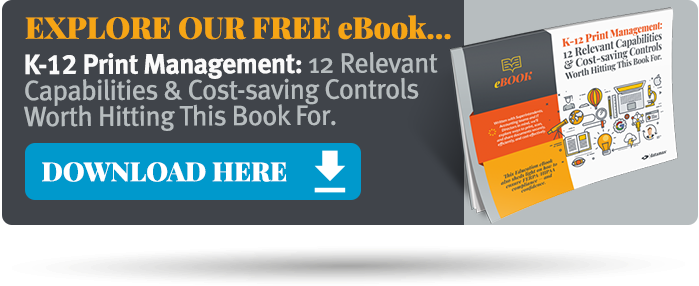
For schools and their print environment, it’s about managing print behavior and costs in order to maximize their allotted budget. Print Management can help with that.
Schools are unique animals when it comes to printing.
So many users. So many types of devices. So many types of documents, all of which are essential to classroom functionality. On top of that, the classroom (and technology therein) is changing rapidly. Whether education is conducted on-site, remotely, or in a combination of both, the technology utilized should seamlessly integrate with different educational applications and offer cost-effective features, enabling schools to make the most of their resources.
For schools and their print environment, it’s about managing print behavior and costs in order to maximize their allotted budget. Print Management can help with that.
What is Print Management?
What is print management? It’s a software-based solution (i.e. Canon uniFLOW) that helps your business better manage your devices and users via print rules and reporting while delivering a user-friendly, secure print/scan experience through a variety of capabilities. We want to share a few of those capabilities here.
12 Print Management Capabilities for K-12 Campuses to Explore for a Better User Experience and Greater Control.
1. Secure Print from Anywhere. Anytime.
Users utilizing Secure Print technology can print with authentication from wherever they’re teaching, learning, or administering. They can print via email, mobile app, or Apple AirPrint. Powered by the Remote User Interface, no matter how a print job is submitted, it will be held in a personal print queue until released with secure user authentication.
2. Flexible Authentication at the Device.
With flexible authentication, the access of print devices is easily controlled. Educators, staff, and students choose from multiple authentication options, such as card log-in, user name/password, PIN code, job code, and anonymous log-in.
3. Remote Printing via Smart Phone or Tablet.
Regardless of their physical location, your users can leverage their compatible smartphones or tablets to submit and release their print jobs in a managed setting. Whatever the preferred method your user chooses to submit a job, it will appear in their personal Secure Print queue, they’ll be accounted for and charged back correctly.
4. Guest Email & Printing.
Whether it’s a visiting instructor, presenter, or important administrative guest, your temporary user will receive an email containing a temporary job code for authentication at the device, offering an easy way to print presentations, curriculum or other documents securely.
5. Least-cost Print Job Routing.
Teachers and students sharing printers? Absolutely. With least-cost job routing, IT administrators can restrict small print jobs to be routed to smaller desktop laser printers while directing larger jobs to be rerouted to faster more cost-effective MFPs.
6. Integrated Cost Tracking and Control.
To ensure that schools control costs and reduce waste, they must first visualize how the printing budget is being spent. The ability to track, assess, and charge back all printing, copying, scanning, and faxing costs on any enabled device is key to discovering real savings. Is high color volume a concern? These jobs can be routed to more appropriate, cost-effective devices (or restricted all altogether when department funds are depleted).
7. Device Monitoring, Alerts, and Reporting.
With device status monitoring, alerts, and reporting, IT personnel can monitor the status of your entire enabled print fleet, facilitating control of all devices. They can then send automated department and user device usage reports to the Superintendent. They benefit from an instant overview of every enabled device in their location, including media and toner levels.
8. Universal Driver Management.
Universal Driver Management technology allows users to choose any network printer from which to release a job, regardless of model or manufacturer. This ensures correct output and, in turn, cuts waste. It also cures constant IT headaches.
9. Intelligent Document Process Creation.
With Intelligent Document Processes at play, accounting teams can scan documents
directly from their MFP copiers and scanners into relevant workflow processes that can be customized according to individual needs.
10. Documents Distributed Wherever Needed.
Flexibility is a key component of distribution. With the right document sharing capabilities, your users can easily distribute them to a variety of destinations. Any number of collaborative
applications (like Microsoft Sharepoint, Laserfiche) or cloud-based destinations like OneDrive, DropBox, or Google Drive, can be part of your desired destinations.
11. Process All Captured Information.
Users can process documents using extremely accurate OCR scanning or barcode functionality to extract information from documents. This capture “to” and “from” process supports a variety of applications, such as Google Chrome, Apple AirPrint, and Google Cloud Storage.
12. Personalized Follow-Me Scan Workflows.
Utilizing more than 30+ scan connectors/scan destinations and optional project-based design of
scan workflows, your school’s administrative team can decide precisely what should happen when users scan a document. They can also grant different access rights to workflows for single users and groups.
How Can You Learn More About Controlling Your Print and Print Workflows through Print Management?
One great way to start? Schedule your visit with a Datamax Print Specialist, who can learn more about your print-related challenges, security concerns, or workflow-enhancing opportunities. Click to schedule your visit!



